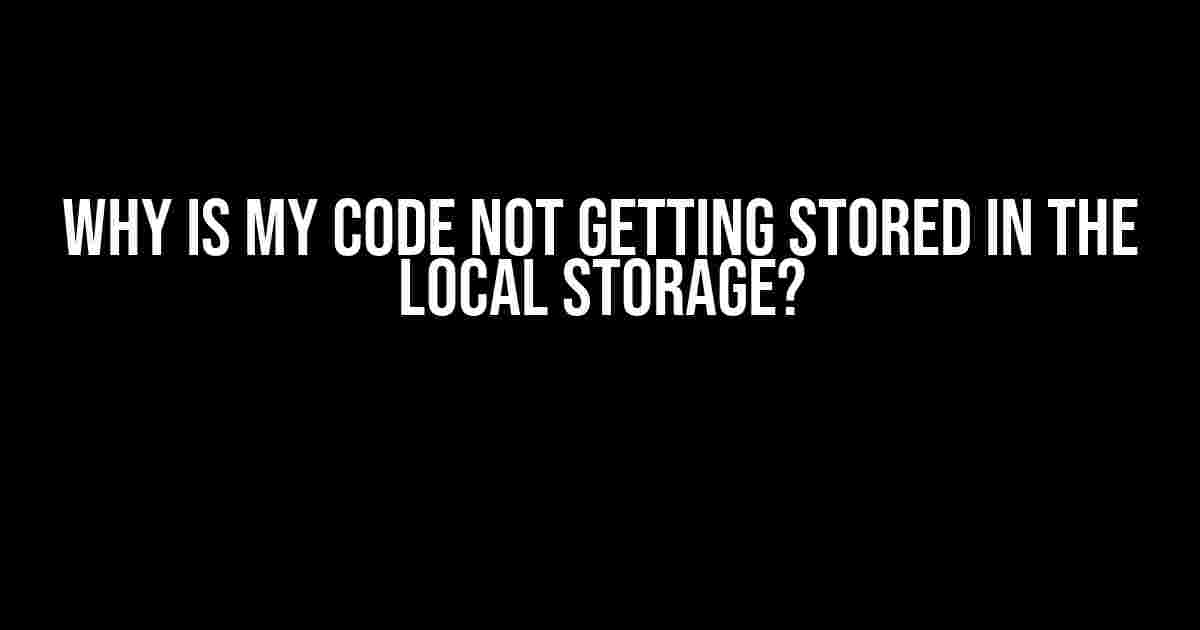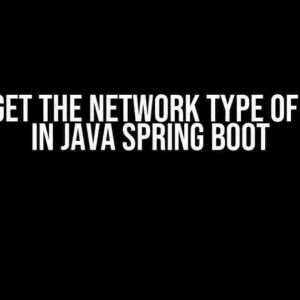Are you frustrated because your code isn’t getting stored in local storage? Don’t worry, you’re not alone! This is a common issue many developers face, and today, we’re going to dive into the reasons why this might be happening and provide you with solutions to get your code stored in local storage.
What is Local Storage?
Before we dive into the problem, let’s quickly understand what local storage is. Local storage, also known as web storage, is a way to store data locally within the user’s browser. It allows you to store data in the form of key-value pairs, which can be accessed and manipulated using JavaScript.
Why Use Local Storage?
Local storage is useful for several reasons:
- It allows you to store data client-side, reducing the need for server-side storage.
- It provides fast access to data, as it’s stored locally within the browser.
- It’s secure, as the data is stored on the client-side and not transmitted to the server.
Reasons Why Your Code Isn’t Getting Stored in Local Storage
Now that we’ve covered the basics of local storage, let’s explore the reasons why your code might not be getting stored in local storage.
1. Syntax Errors
Syntax errors are one of the most common reasons why your code isn’t getting stored in local storage. A single syntax error can prevent the entire script from running, including the local storage code.
For example, if you’re using the following code to store data in local storage:
localStorage.setItem("key", "value");But you forget to close the script tag, like this:
<script>
localStorage.setItem("key", "value";
</script>The code will throw a syntax error, and the data won’t be stored in local storage.
2. Browser Security Restrictions
Browsers have security restrictions in place to prevent malicious scripts from accessing local storage. If your code is trying to access local storage from a different origin (domain, protocol, or port), it will be blocked by the browser.
For example, if your JavaScript code is hosted on http://example.com, but you’re trying to access local storage from http://subdomain.example.com, it will be blocked by the browser.
3. Local Storage Quota Exceeded
Local storage has a limited quota, which varies from browser to browser. If you exceed the quota, you won’t be able to store any more data in local storage.
For example, if you’re using the following code to store a large amount of data:
for (var i = 0; i < 10000; i++) {
localStorage.setItem("key" + i, "value" + i);
}You might exceed the local storage quota, preventing you from storing any more data.
4. Data Type Issues
Local storage can only store strings. If you’re trying to store other data types, such as objects or arrays, you’ll need to convert them to strings first.
For example, if you’re trying to store an object using the following code:
var obj = { name: "John", age: 30 };
localStorage.setItem("user", obj);The code will throw an error, as local storage can only store strings. Instead, you should convert the object to a string using JSON.stringify():
var obj = { name: "John", age: 30 };
localStorage.setItem("user", JSON.stringify(obj));5. Incorrect Usage of setItem() and getItem()
The setItem() and getItem() methods are used to store and retrieve data from local storage, respectively. However, if you’re using them incorrectly, you might not be able to store or retrieve data.
For example, if you’re using the following code to store data:
localStorage.setItem("key", "value", "newvalue");The code will throw an error, as the setItem() method only takes two arguments: the key and the value.
Solutions to Get Your Code Stored in Local Storage
Now that we’ve explored the reasons why your code might not be getting stored in local storage, let’s provide solutions to get your code stored in local storage.
1. Use the Correct Syntax
Make sure you’re using the correct syntax when storing data in local storage. Use the setItem() method to store data, like this:
localStorage.setItem("key", "value");2. Handle Browser Security Restrictions
If you’re accessing local storage from a different origin, make sure you’re using the correct protocol, domain, and port. You can also use the localStorage.setItem() method with the same-origin policy to ensure that the data is only accessible from the same origin.
3. Check the Local Storage Quota
Make sure you’re not exceeding the local storage quota. You can check the quota using the following code:
if (localStorage.remainingSpace <= 0) {
console.log("Local storage quota exceeded.");
}4. Convert Data Types to Strings
Make sure you’re converting data types to strings before storing them in local storage. Use the JSON.stringify() method to convert objects and arrays to strings.
var obj = { name: "John", age: 30 };
localStorage.setItem("user", JSON.stringify(obj));5. Use the Correct setItem() and getItem() Methods
Make sure you’re using the correct setItem() and getItem() methods. Use the setItem() method to store data, like this:
localStorage.setItem("key", "value");And use the getItem() method to retrieve data, like this:
var value = localStorage.getItem("key");Best Practices for Using Local Storage
Here are some best practices for using local storage:
- Use the correct syntax and data types when storing data in local storage.
- Handle browser security restrictions by using the correct protocol, domain, and port.
- Check the local storage quota to avoid exceeding it.
- Use JSON.stringify() to convert objects and arrays to strings.
- Use the getItem() method to retrieve data from local storage.
Conclusion
In this article, we’ve explored the reasons why your code might not be getting stored in local storage, along with solutions to get your code stored in local storage. By following the best practices outlined in this article, you can ensure that your code is stored in local storage correctly and efficiently.
| Reason | Solution |
|---|---|
| Syntax Errors | Use the correct syntax when storing data in local storage. |
| Browsers Security Restrictions | Handle browser security restrictions by using the correct protocol, domain, and port. |
| Local Storage Quota Exceeded | Check the local storage quota to avoid exceeding it. |
| Data Type Issues | Use JSON.stringify() to convert objects and arrays to strings. |
| Incorrect Usage of setItem() and getItem() | Use the correct setItem() and getItem() methods. |
We hope this article has been helpful in resolving the issue of why your code isn’t getting stored in local storage. If you have any further questions or concerns, feel free to ask in the comments below!
Frequently Asked Question
Are you stuck with your code not getting stored in the local storage? Don’t worry, we’ve got you covered! Here are some common reasons and solutions to get you back on track:
Is my browser blocking local storage?
Yes, it’s possible! Some browsers, especially in private or incognito mode, may block local storage. Try checking your browser settings or switching to a different browser to rule out this possibility.
Am I using the correct syntax?
Double-check your code for any syntax errors! Make sure you’re using the correct method to store data in local storage, such as `localStorage.setItem(‘key’, ‘value’)` or `window.localStorage.setItem(‘key’, ‘value’)`. A small mistake can prevent your code from working.
Is local storage full or corrupted?
It’s possible that your local storage is full or corrupted. Try clearing your browser’s local storage and trying again. You can also check the storage size using `localStorage.length` and adjust your storage needs accordingly.
Are there any security restrictions?
Yes, some browsers or devices may have security restrictions that block local storage. For example, iOS devices may block local storage in certain situations. Make sure you’re testing your code in a suitable environment.
Am I checking the storage correctly?
Don’t forget to check your local storage after setting the item! Use `localStorage.getItem(‘key’)` or `window.localStorage.getItem(‘key’)` to verify that your data is being stored correctly. You can also use the browser’s developer tools to inspect the local storage.




